June 12th, 2006
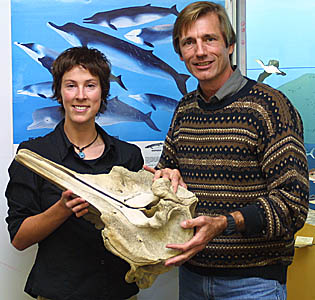 Four whales stranded on the coast of California in the 1970s were identified as Hector’s beaked whale Mesoplodon hectori (Mead 1981 J Mammalogy 62:430). 20 years later mitochondrial DNA analysis revealed these 4 specimens, and a fifth stranded in 1997, to be a new species, designated Perrin’s beaked whale Mesoplodon perrini (Dalebout et al 2002 Marine Mammal Sci 18:577). The presence of a new species was first recognized by researchers compiling a database of mitochondrial DNA to assist in species identification. The formal species description includes diagnostic molecular characters, helping integrate DNA sequence data with classical taxonomy. As emphasized by Rob DeSalle and others, there is a need to interweave phylogeny and classical taxonomy, which can be met by including DNA sequences routinely used for evolutionary analysis as diagnostic characters in species descriptions (DeSalle et al. 2005 Phil Trans Royal Soc B 360:1905).
Four whales stranded on the coast of California in the 1970s were identified as Hector’s beaked whale Mesoplodon hectori (Mead 1981 J Mammalogy 62:430). 20 years later mitochondrial DNA analysis revealed these 4 specimens, and a fifth stranded in 1997, to be a new species, designated Perrin’s beaked whale Mesoplodon perrini (Dalebout et al 2002 Marine Mammal Sci 18:577). The presence of a new species was first recognized by researchers compiling a database of mitochondrial DNA to assist in species identification. The formal species description includes diagnostic molecular characters, helping integrate DNA sequence data with classical taxonomy. As emphasized by Rob DeSalle and others, there is a need to interweave phylogeny and classical taxonomy, which can be met by including DNA sequences routinely used for evolutionary analysis as diagnostic characters in species descriptions (DeSalle et al. 2005 Phil Trans Royal Soc B 360:1905).
I find it remarkable that a species as large as a whale can languish unrecognized in a collection. How many new species lurk in museum drawers awaiting discovery? A comprehensive DNA barcode survey of a tissue collection could be relatively inexpensive, as DNA isolation from tissues is generally simple and and sequencing costs are approaching a $1 a specimen. If whales can hide in museums for 20 years, there must be a multitude of new species already collected that will be uncovered by DNA analysis.
Posted in General by Mark Stoeckle | Comments Off on Undiscovered species lurking in museum drawers
June 6th, 2006
In 7 June 2006 Systematics and Biodiversity Andrew Brower examines application of DNA barcodes to identifying and defining new species. His Perspective piece “Problems with DNA barcodes for species delimitation: ‘ten species’ of Astraptes fulgerator reassessed (Lepidoptera: Hesperiidae)” reviews Hebert et al’s 2004 PNAS paper “Ten species in one: DNA barcoding reveals cryptic species in the neotropical skipper butterfly Astraptes fulgerator. My short summary is that we are still learning about how best to use DNA barcodes for identifying new species. In an April 2006 post responding to another worry piece I wrote: “DNA barcoding is a taxonomic tool for a) assigning specimens to known species and b) speeding discovery of new species. More work is needed to determine the best use of DNA barcodes in species discovery.”
 Brower’s article argues about how many Astraptes species are supported by the sequence data, worries about possible consequences of the rise of DNA barcoding, and misses the scientific opportunity to examine this very young species complex with a large set of morphologic, ecologic, and sequence data. He concedes “there are probably at least three species” but declines to put forth what criteria can be used to delimit species. I was surprised to read that the question of whether two sequences “belong to the ‘same species’ is a metaphysical one”.
Brower’s article argues about how many Astraptes species are supported by the sequence data, worries about possible consequences of the rise of DNA barcoding, and misses the scientific opportunity to examine this very young species complex with a large set of morphologic, ecologic, and sequence data. He concedes “there are probably at least three species” but declines to put forth what criteria can be used to delimit species. I was surprised to read that the question of whether two sequences “belong to the ‘same species’ is a metaphysical one”.
A brief summary may be helpful. The PNAS Astraptes paper reports on 25 years of ecological and morphological work on Astraptes fulgerator larva and adults in a conservation area in northwestern Costa Rica. Approximately 40% of the 2,592 A. fulgerator caterpillars collected over this interval were successfully raised to adult; DNA barcodes were derived from the adult specimens. Differences in larval morphology and food plants and in some cases subtle differences in adult morphology suggested the presence of 6-7 cryptic species. When ADDED to this very large natural history knowledge base, DNA barcoding supported these inferences and highlighted another possible 3 or 4 species. The number of individuals sequenced is larger (4-103 per putative species; 7 of 10 with more than 40 specimens sequenced) than in any other single species study I am aware of. Despite the large sample sizes and detailed information on biological co-variation in ecological and morphological traits, Brower seems to read the paper as defining species based on DNA barcodes. According to his own analysis, NJ bootstrap recovered 7 species and cladistic haplotype analysis recovered 8, albeit with low statistical support. The argument over whether some of the putative species are established to be distinct biological entities is important for the Astraptes specialist, but misses the point of how well barcode lineages in the neighbor-joining tree match differences in biology in this VERY YOUNG species complex. To my reading, the findings suggest that if one were starting over, or starting with a unstudied group, using DNA barcoding as a first step would be the fastest way for taxonomists to sort specimens and find new species.
Posted in General by Mark Stoeckle | Comments Off on Learning how to apply DNA barcoding to species discovery
June 2nd, 2006
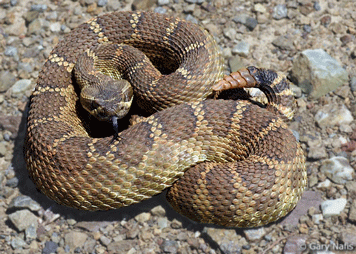 If you hear this sound
If you hear this sound  watch your step–a venomous rattlesnake may be nearby! Prompt administration of the correct antivenom can be life-saving.
watch your step–a venomous rattlesnake may be nearby! Prompt administration of the correct antivenom can be life-saving.
The essential first step in toxinological research is reproducible analyses of venom toxins. However, in December 2005 Toxicon 46: 711-715 Pook and McEwing, University of Wales, report that reproducibility of toxin analyses is commonly compromised by “misidentification of species due to insufficient or changing knowledge of current snake systematics.”
Their article describes a breakthrough in toxinological research: DNA barcoding of dried venoms to provide an accurate, permanent “label” that is independent of future taxonomic changes. This short article is a powerful demonstration of how a standardized approach to identifying species by DNA that uses a public database linked to vouchered specimens, i.e. DNA barcoding, can benefit science and society. While some taxonomists will continue to wring their hands, others may be excited by this work, as it demonstrates how DNA barcoding ADDED TO (and not replacing) standard systematic practice can improve the accessibility and usefulness of ongoing taxonomic work for the larger biological community. I believe this article is enormously important, and I quote here at length.
From the Introduction: “Erroneous or uncertain taxonomy confuses the interpretation of results with respect to intraspecific and interspecific variation. Genuine logistical problems are encountered by non-specialists in taxonomy and snake systematics, in being able to keep up with taxonomic changes. The main hindrances include unresolved taxonomy for some species groups, and new data that change the definition of taxonomic units in others, with the result that the use of systematic information in the toxinological and clinical literature is disorganised. The problem is compounded further by changes in the concept of a particular species, and hence the interpretability of the venom used. Taxonomic confusion, however, has serious implications in snake venom research. The development of effective antivenom treatments and treatment strategies for envenomized patients necessitates a sound taxonomic framework. Accurate clarification of the identity of a given venom is paramount, even after taxonomic revisions involving the species concerned.”
Pook and McEwing “propose a solution to the long-term problem of species identification in toxinological work, utilising mitochondrial haplotypes isolated directly from snake venoms to provide a means of identification that will remain useful even in the face of radical changes in our understanding of the species concerned.”
From the conclusion: “The barcode strategy is dependent on the availablity of known mtDNA haplotype standards against which the sequences being investigated can be compared. Mitochondrial haplotype standards should be gene sequences from snakes of confirmed identity, which have been accessioned to a museum collection as voucher specimens.”
Posted in General, Papers by Mark Stoeckle | Comments Off on DNA barcoding snake venoms helps toxinologists save lives
May 30th, 2006
In Barcoding Life, Illustrated we suggested that “standardization typically lowers costs and lifts reliability…and should help accelerate construction of comprehensive, consistent reference library of DNA sequences and development of economical technologies for species identification.” However, some have been doubtful about the benefits of standardization. This reflects in part the balkanized nature of taxonomic science, as most systematists specialize on groups of related organisms and have limited scientific interactions with those studying other groups. Last year Jesse Ausubel and Paul Waggoner outlined some of the concerns raised by the growth of DNA barcoding in Barcoding Worries and Limits. The final item asks whether “it is too soon to standardize on a very few localities”. The salamander paper discussed in last week’s post seems to support this concern, as it implies that the relative rates of evolution of mitochondrial genes differ between animal groups. According to the paper, in salamanders COI evolves much more rapidly than other mitochondrial protein-coding genes.
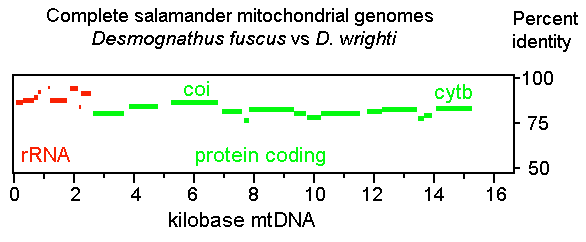
However, as detailed below, my analysis indicates that salamanders are unexceptional in terms of COI differences. I find evolutionary divergences are widely distributed in mitochondrial protein-coding genes and the patterning of these differences is similar in diverse invertebrate and vertebrate organisms, including salamanders. First, I used PipMaker (percent identity plot) to examine the distribution of sequence differences in complete mitochondrial genomes. A representative PipMaker plot, shown above, compares the mitochondrial genomes of 2 plethodontid salamanders, Desmognathus fuscus and D. wrighti, revealing a typical pattern of widely distributed sequence differences. As in most vertebrates, in salamanders COI is slightly LESS divergent (14%) than other protein-coding regions, including cytochrome b (CYTB) (17%).
Second, I compiled differences between closely-related species pairs in CYTB and COI. For historical reasons, CYTB has been the single most common locus used to analyze differences in vertebrate species, and COI has been the single most common single locus for invertebrates. As shown below, these genes show highly correlated differences in deeply divergent lineages of invertebrates and vertebrates, including salamanders.
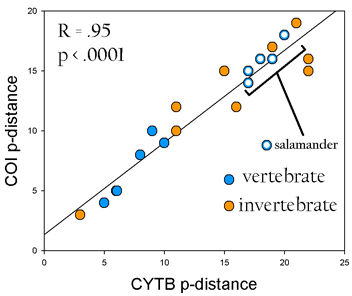
Species examined include Demospongiae (sponges); Platyhelminthes (tapeworms); Echinodermata (starfish); Arthropoda (ticks; fruit flies; mosquitos; shrimp); Mollusca (octopi; mantis shrimp) Vertebrata (turtles; eels; coelecanths; elephants; wolves; apes; and 5 pairs of congeneric salamanders)
These findings support standardizing on COI as the primary DNA barcode for multicellular animals. As discussed in earlier posts, there will of course be cases in which the primary barcode does not resolve closely-related species and a secondary barcode(s) may be needed.
Posted in General by Mark Stoeckle | Comments Off on Salamanders support standardization
May 25th, 2006
Pest and invasive species in agricultural crops and shipped goods pose enormous economic and biosecurity threats. Rapidly and reliably identifying pests and invasives in all life stages is likely to be one of the most economically important applications of DNA barcoding. In March 2006 Ann Entomol Soc Am 99: 204 Scheffer, Lewis, and Joshi from the USDA and the Philippine Department of Agriculture apply DNA barcoding to invasive leafminer flies in the Philippines. 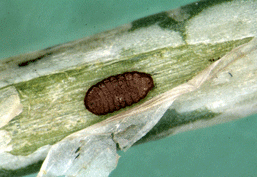 They analyzed 258 specimens from the Philippines and compared these to a database of 307 sequences previously collected from worldwide populations. Bootstrap values for all species were 100%. In addition, a total of 7 distinct clusters with 98-100% bootstrap support were found in 3 “morphospecies”, suggesting discovery of new species, similar to findings of unrecognized biodiversity in all DNA barcode surveys to date. They conclude “DNA barcoding of economically and medically important species offers a powerful means of rapid identification”.
They analyzed 258 specimens from the Philippines and compared these to a database of 307 sequences previously collected from worldwide populations. Bootstrap values for all species were 100%. In addition, a total of 7 distinct clusters with 98-100% bootstrap support were found in 3 “morphospecies”, suggesting discovery of new species, similar to findings of unrecognized biodiversity in all DNA barcode surveys to date. They conclude “DNA barcoding of economically and medically important species offers a powerful means of rapid identification”.
With DNA barcoding, all can identify this Liriomyza sativae pupae
Posted in General, Papers by Mark Stoeckle | 1 Comment »
May 22nd, 2006
Results so far in animals suggest the major limitation to DNA barcoding is very young species pairs. Young species pairs may not have accumulated enough differences in the 648 bp barcode region of COI to form distinct lineages in neighbor-joining analysis. Because overall rates of mitochondrial DNA evolution differ among animal groups, and the relative rates of specific mitochondrial genes also differ, it may turn out that COI barcoding will be more effective in separating young species pairs in some groups than in others.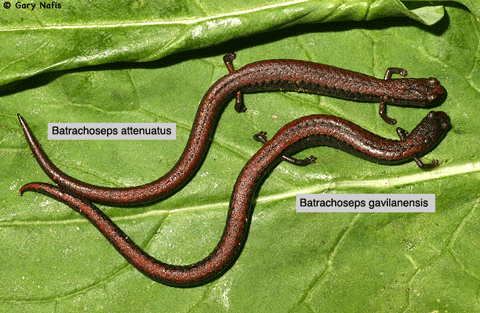
20 My of genetic divergence and morphologic stasis
In April 2006 Systematic Biology Mueller compares complete mitochondrial genomes of 27 salamander species. The genetics of salamanders are particularly important as they are notoriously difficult to distinguish and classify due to morphologic stasis and frequent homoplasy. Many new species of salamanders have been discovered and described on the basis of mitochondrial divergence. Mueller found that COI has the highest rate of evolution among all mitochondrial genes in salamanders, suggesting it will be especially effective at resolving young species in this group. Despite these very encouraging results, the paper ends with a worried discussion about using COI for DNA barcoding of salamanders, because its evolutionary rate varies between lineages.
A better appreciation of the power of a standardized genetic approach for amphibians is Ron et al.’s paper in May 2006 Molecular Phylogenetics and Evolution which uses mitochondrial DNA to look at phylogeny and new species in the Neotropical tungara frog genus Engystomops. The authors observe that “the use of genetic markers in systematics has an enormous potential to facilitate the global inventory of biodiversity”, and conclude, based on their results and those in similar studies, that “the increasing use of molecular techniques will lead to the discovery of a vast number of species of Neotropical amphibians.”
Posted in General, Papers by Mark Stoeckle | 1 Comment »
May 19th, 2006
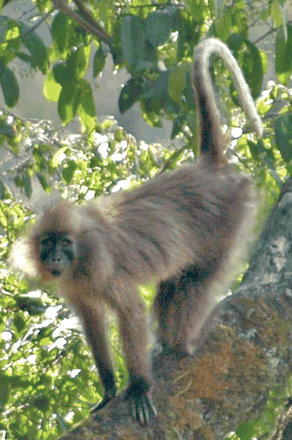 A year ago in Science, Jones et al. described a new species of African monkey, Lophocebus kipunji, documenting their report with field observations, sound recordings, and photographs. This led to legalistic wrangling over whether the species could be said to exist if there was no specimen! Fortunately, the suspense is relieved by Davenport et al. in this month’s Science, in which they provide morphologic and DNA information based on a specimen recovered from a farmer’s trap. Although the authors relied on mitochondrial DNA evidence to establish the monkey belongs in a new genus, Rungwecebus, the actual sequence data is not listed among diagnostic characters in the species or genus description. Routine inclusion of DNA barcode sequences could improve the usefulness of formal species descriptions, assisting primate conservation efforts that monitor bushmeat trade, for example.
A year ago in Science, Jones et al. described a new species of African monkey, Lophocebus kipunji, documenting their report with field observations, sound recordings, and photographs. This led to legalistic wrangling over whether the species could be said to exist if there was no specimen! Fortunately, the suspense is relieved by Davenport et al. in this month’s Science, in which they provide morphologic and DNA information based on a specimen recovered from a farmer’s trap. Although the authors relied on mitochondrial DNA evidence to establish the monkey belongs in a new genus, Rungwecebus, the actual sequence data is not listed among diagnostic characters in the species or genus description. Routine inclusion of DNA barcode sequences could improve the usefulness of formal species descriptions, assisting primate conservation efforts that monitor bushmeat trade, for example.
Where is my barcode?
Posted in General, Papers by Mark Stoeckle | 1 Comment »
May 16th, 2006
In “Estimating diversity of Indo-Pacific coral reef stomatopods through DNA barcoding of stomatopod larvae” (FirstCite early online publication in Proceedings Royal Society Biology) Paul Barber and Sarah Boyce, Boston University, look at 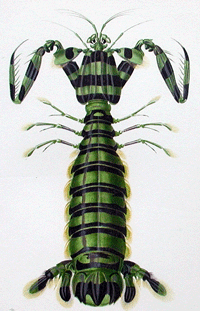 a what is thought to be a well-understood group, stomatopods, commonly known as mantis shrimp. Stomatopods are marine crustaceans distinct from true shrimp and are thought to include about 400 species worldwide. Like many marine species, they have a bipartite life cycle where dispersal is achieved through a planktonic larval developmental stage. However, larval stages are notoriously difficult to identify morphologically. Barber and Boyce first established a database of COI DNA barcodes from adult forms of nearly all known species. They then applied DNA barcoding to planktonic larvae collected in light traps at locations in the Pacific Ocean and Red Sea. Comparison of
a what is thought to be a well-understood group, stomatopods, commonly known as mantis shrimp. Stomatopods are marine crustaceans distinct from true shrimp and are thought to include about 400 species worldwide. Like many marine species, they have a bipartite life cycle where dispersal is achieved through a planktonic larval developmental stage. However, larval stages are notoriously difficult to identify morphologically. Barber and Boyce first established a database of COI DNA barcodes from adult forms of nearly all known species. They then applied DNA barcoding to planktonic larvae collected in light traps at locations in the Pacific Ocean and Red Sea. Comparison of 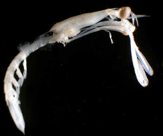 sequences from 189 larval forms revealed 22 distinct larval operational taxonomic units (OTUs), but a minority of these matched known species, suggesting that stomatopod species diversity is underestimated by a minimum of 50% to more than 150%. Their results support general use of DNA barcoding as a rapid, relatively-inexpensive first step in cataloging marine species with planktonic larvae. A similar approach has been applied on land by Smith et al “DNA barcoding for effective biodiversity assessment of a hyperdiverse arthropod group: the ants of Madagascar“.
sequences from 189 larval forms revealed 22 distinct larval operational taxonomic units (OTUs), but a minority of these matched known species, suggesting that stomatopod species diversity is underestimated by a minimum of 50% to more than 150%. Their results support general use of DNA barcoding as a rapid, relatively-inexpensive first step in cataloging marine species with planktonic larvae. A similar approach has been applied on land by Smith et al “DNA barcoding for effective biodiversity assessment of a hyperdiverse arthropod group: the ants of Madagascar“.
DNA barcode OTUs, such as found in these studies, are not equivalent to species descriptions and are not sufficient to establish systematic phylogeny. In my view, these studies indicate that DNA barcodes can be permanent indexers for filing and retrieving biologic information in the encyclopedia of life. Routinely incorporating DNA barcoding into biological surveys will enhance the long-term value of expensive field work.
Posted in General by Mark Stoeckle | Comments Off on To rapidly map biodiversity, stomatopods suggest start with DNA
May 13th, 2006
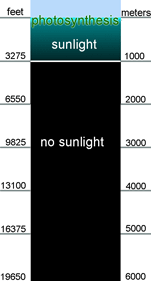 The deep oceans are the largest biotic space on earth, but remain largely unexplored. Census of Marine Life scientists recently trawled the Atlantic between the southeast US coast and the Mid-Atlantic ridge, focusing on the zone of perpetual darkness that lies below about 1000 m, to inventory and photograph the variety and abundance of zooplankton–the tiny sea animals that form a vital link in ocean food chains. The 20 day cruise completed April 20 is part of the ambitious gobal inventory of zooplankton by 2010 (Census of Marine Zooplankton (CMarZ), a Census of Marine life initiative. As reported in Science, for the first time DNA sequencing was performed on the rolling seas, telescoping into just three weeks what would normally represent years of laboratory work.
The deep oceans are the largest biotic space on earth, but remain largely unexplored. Census of Marine Life scientists recently trawled the Atlantic between the southeast US coast and the Mid-Atlantic ridge, focusing on the zone of perpetual darkness that lies below about 1000 m, to inventory and photograph the variety and abundance of zooplankton–the tiny sea animals that form a vital link in ocean food chains. The 20 day cruise completed April 20 is part of the ambitious gobal inventory of zooplankton by 2010 (Census of Marine Zooplankton (CMarZ), a Census of Marine life initiative. As reported in Science, for the first time DNA sequencing was performed on the rolling seas, telescoping into just three weeks what would normally represent years of laboratory work.
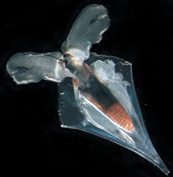 According to Ann Bucklin, lead scientist for CMarZ and Head of the University of Connecticut Marine Sciences Department, “we are just starting to realize how little we know about species variety. We used to think we knew many species well, but the advent of DNA barcoding has radically altered that perception. Genetically distinctive species of zooplankton are being found with increasing frequency.”
According to Ann Bucklin, lead scientist for CMarZ and Head of the University of Connecticut Marine Sciences Department, “we are just starting to realize how little we know about species variety. We used to think we knew many species well, but the advent of DNA barcoding has radically altered that perception. Genetically distinctive species of zooplankton are being found with increasing frequency.”
Posted in General by Mark Stoeckle | Comments Off on Zooplankton sequenced at sea, illuminating life in the dark
May 10th, 2006
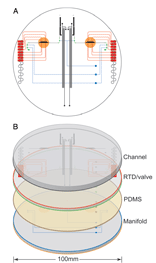 ABI’s smallest sequencer is about the size and weight of a house air conditioning unit [ABI 310: 95 kg (208 lbs); 61 x 56 x 86 cm (24 x 22 x 34 in)]. Researchers who developed the Mars Organic Analyzer for detecting extraterrestrial life recently turned their attention to DNA sequencing. In 9 May 2006 PNAS Blazej, Kumaresan, and Mathies from the University of California, Berkeley, report on a microfabricated DNA sequencer comprised of three 10 cm glass wafers. Using 1 femtomole of DNA template and a 250 nanoliter reaction chamber, the device performs thermal cycling, DNA purification, and capillary electrophoresis, generating reads of up to 556 bases with 99% accuracy. Based on their results “the template/reagent requirements can be reduced an additional 100-fold, and a fully integrated microfluidic genomic sequencing system should also lead to significant infrastructure and labor savings.”
ABI’s smallest sequencer is about the size and weight of a house air conditioning unit [ABI 310: 95 kg (208 lbs); 61 x 56 x 86 cm (24 x 22 x 34 in)]. Researchers who developed the Mars Organic Analyzer for detecting extraterrestrial life recently turned their attention to DNA sequencing. In 9 May 2006 PNAS Blazej, Kumaresan, and Mathies from the University of California, Berkeley, report on a microfabricated DNA sequencer comprised of three 10 cm glass wafers. Using 1 femtomole of DNA template and a 250 nanoliter reaction chamber, the device performs thermal cycling, DNA purification, and capillary electrophoresis, generating reads of up to 556 bases with 99% accuracy. Based on their results “the template/reagent requirements can be reduced an additional 100-fold, and a fully integrated microfluidic genomic sequencing system should also lead to significant infrastructure and labor savings.”
Faster, cheaper, more portable sequencing should facilitate “point-of-use” DNA barcoding devices for identifying specimens in the field, detecting invasive species at the customs station, and sorting through museum drawers for undescribed species, for example.
Posted in General, Papers by Mark Stoeckle | 1 Comment »
 Four whales stranded on the coast of California in the 1970s were identified as Hector’s beaked whale Mesoplodon hectori (Mead 1981 J Mammalogy 62:430). 20 years later mitochondrial DNA analysis revealed these 4 specimens, and a fifth stranded in 1997, to be a new species, designated Perrin’s beaked whale Mesoplodon perrini (Dalebout et al 2002 Marine Mammal Sci 18:577). The presence of a new species was first recognized by researchers compiling a database of mitochondrial DNA to assist in species identification. The formal species description includes diagnostic molecular characters, helping integrate DNA sequence data with classical taxonomy. As emphasized by Rob DeSalle and others, there is a need to interweave phylogeny and classical taxonomy, which can be met by including DNA sequences routinely used for evolutionary analysis as diagnostic characters in species descriptions (DeSalle et al. 2005 Phil Trans Royal Soc B 360:1905).
Four whales stranded on the coast of California in the 1970s were identified as Hector’s beaked whale Mesoplodon hectori (Mead 1981 J Mammalogy 62:430). 20 years later mitochondrial DNA analysis revealed these 4 specimens, and a fifth stranded in 1997, to be a new species, designated Perrin’s beaked whale Mesoplodon perrini (Dalebout et al 2002 Marine Mammal Sci 18:577). The presence of a new species was first recognized by researchers compiling a database of mitochondrial DNA to assist in species identification. The formal species description includes diagnostic molecular characters, helping integrate DNA sequence data with classical taxonomy. As emphasized by Rob DeSalle and others, there is a need to interweave phylogeny and classical taxonomy, which can be met by including DNA sequences routinely used for evolutionary analysis as diagnostic characters in species descriptions (DeSalle et al. 2005 Phil Trans Royal Soc B 360:1905).  Brower’s article argues about how many Astraptes species are supported by the sequence data, worries about possible consequences of the rise of DNA barcoding, and misses the scientific opportunity to examine this very young species complex with a large set of morphologic, ecologic, and sequence data. He concedes “there are probably at least three species” but declines to put forth what criteria can be used to delimit species. I was surprised to read that the question of whether two sequences “belong to the ‘same species’ is a metaphysical one”.
Brower’s article argues about how many Astraptes species are supported by the sequence data, worries about possible consequences of the rise of DNA barcoding, and misses the scientific opportunity to examine this very young species complex with a large set of morphologic, ecologic, and sequence data. He concedes “there are probably at least three species” but declines to put forth what criteria can be used to delimit species. I was surprised to read that the question of whether two sequences “belong to the ‘same species’ is a metaphysical one”. 





 A year ago in Science,
A year ago in Science,  a what is thought to be a well-understood group, stomatopods, commonly known as mantis shrimp. Stomatopods are marine crustaceans distinct from true shrimp and are thought to include about 400 species worldwide. Like many marine species, they have a bipartite life cycle where dispersal is achieved through a planktonic larval developmental stage. However, larval stages are notoriously difficult to identify morphologically. Barber and Boyce first established a database of COI DNA barcodes from adult forms of nearly all known species. They then applied DNA barcoding to planktonic larvae collected in light traps at locations in the Pacific Ocean and Red Sea. Comparison of
a what is thought to be a well-understood group, stomatopods, commonly known as mantis shrimp. Stomatopods are marine crustaceans distinct from true shrimp and are thought to include about 400 species worldwide. Like many marine species, they have a bipartite life cycle where dispersal is achieved through a planktonic larval developmental stage. However, larval stages are notoriously difficult to identify morphologically. Barber and Boyce first established a database of COI DNA barcodes from adult forms of nearly all known species. They then applied DNA barcoding to planktonic larvae collected in light traps at locations in the Pacific Ocean and Red Sea. Comparison of  sequences from 189 larval forms revealed 22 distinct larval operational taxonomic units (OTUs), but a minority of these matched known species, suggesting that stomatopod species diversity is underestimated by a minimum of 50% to more than 150%. Their results support general use of DNA barcoding as a rapid, relatively-inexpensive first step in cataloging marine species with planktonic larvae. A similar approach has been applied on land by Smith et al “
sequences from 189 larval forms revealed 22 distinct larval operational taxonomic units (OTUs), but a minority of these matched known species, suggesting that stomatopod species diversity is underestimated by a minimum of 50% to more than 150%. Their results support general use of DNA barcoding as a rapid, relatively-inexpensive first step in cataloging marine species with planktonic larvae. A similar approach has been applied on land by Smith et al “ The deep oceans are the largest biotic space on earth, but remain largely unexplored.
The deep oceans are the largest biotic space on earth, but remain largely unexplored.  According to Ann Bucklin, lead scientist for CMarZ and Head of the University of Connecticut Marine Sciences Department, “we are just starting to realize how little we know about species variety. We used to think we knew many species well, but the advent of DNA barcoding has radically altered that perception. Genetically distinctive species of zooplankton are being found with increasing frequency.”
According to Ann Bucklin, lead scientist for CMarZ and Head of the University of Connecticut Marine Sciences Department, “we are just starting to realize how little we know about species variety. We used to think we knew many species well, but the advent of DNA barcoding has radically altered that perception. Genetically distinctive species of zooplankton are being found with increasing frequency.”  ABI’s smallest sequencer is about the size and weight of a house air conditioning unit [ABI 310: 95 kg (208 lbs); 61 x 56 x 86 cm (24 x 22 x 34 in)]. Researchers who developed the
ABI’s smallest sequencer is about the size and weight of a house air conditioning unit [ABI 310: 95 kg (208 lbs); 61 x 56 x 86 cm (24 x 22 x 34 in)]. Researchers who developed the